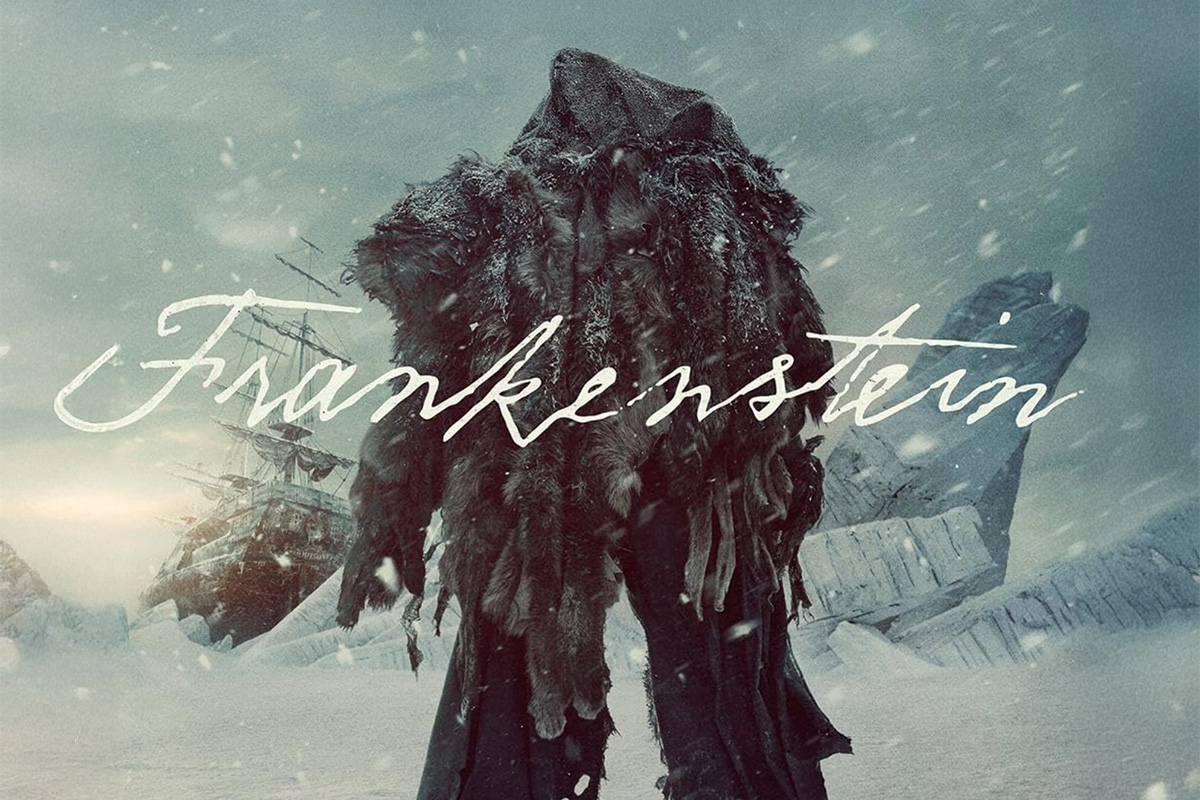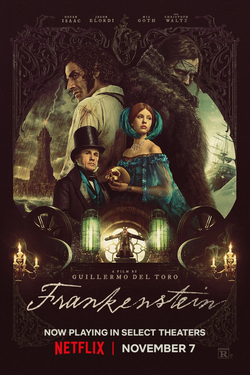Frankenstein (2025) – Is This the Movie of the Year?
Guillermo del Toro’s Frankenstein (2025) is a visually breathtaking and emotionally powerful adaptation of Mary Shelley’s classic. With Oscar Isaac as Victor Frankenstein and Jacob Elordi delivering a remarkable performance as the Creature, the film blends horror, tragedy, and humanity into one of the year’s most memorable cinematic experiences. A faithful yet fresh retelling, it stands as a strong contender for Movie of the Year.

Frankenstein (2025) – Is This the Movie of the Year?

Frankenstein
2025 / 150m
Director:
Guillermo del Toro
I don’t usually associate Netflix with consistent high-quality filmmaking, but every now and then the platform produces a collaboration that simply can’t be ignored. Guillermo del Toro’s Frankenstein is one such project. Del Toro, one of the most distinctive directors working today, has spent nearly 30 years blending fantasy and horror into films that are, above all else, deeply human. His decision to adapt Mary Shelley’s classic novel feels not only fitting but inevitable — almost as if this story had been waiting for him all along.
From the very first scenes, the film immerses us in a lush, painterly world filled with vibrant colors and meticulously crafted details. Many movies today look visually impressive, but this one is worth watching for its cinematography alone. Every frame is breathtaking, though for anyone familiar with Del Toro’s work, this isn’t a surprise — it’s an expectation. Fortunately, the film offers more than visual splendor. Its cast, stacked with remarkable talent, delivers on every front. Oscar Isaac gives an intense and layered performance as Victor Frankenstein, while Jacob Elordi is extraordinary as the Creature — easily his career-best performance so far, and in my honest opinion, one of the greatest portrayals of Frankenstein’s Monster ever put on screen. Mia Goth completes the film’s emotional core as Elizabeth (and Victor’s mother, bringing the film a Freudian moment) giving depth and warmth to a character often sidelined in previous adaptations.
The supporting cast is just as strong. Christoph Waltz and Charles Dance are, as always, a pleasure to watch, and David Bradley delivers one of the film’s most touching performances as the blind old man. Known for playing abrasive, unpleasant characters such as Argus Filch in Harry Potter and Walder Frey in Game of Thrones, Bradley appears here in a completely different light — gentle, kind, and heartbreaking.
A Faithful Yet Selective Adaptation
Frankenstein has been adapted countless times across film, television, theater, comics, and more. However, very few of these adaptations have remained faithful to Shelley’s original novel. James Whale’s iconic 1931 version, while legendary, introduced major changes: new subplots, altered motives, and most famously, a drastically different interpretation of the Monster. Over the years, the creature’s appearance, personality, and even intelligence have varied dramatically.
Del Toro’s Frankenstein takes a different approach. It is not a remake of any previous film but also not a direct adaptation of the novel. The film makes it clear that it has no interest in replicating earlier interpretations. There is no hunchbacked assistant, no dramatic “It’s alive!” moment, and no elements invented by Hollywood over the last century. Instead, Del Toro returns to Shelley’s original structure, beginning in the Arctic, where an explorer captain encounters a severely wounded Victor Frankenstein. As the crew tends to him, Victor recounts the tragic story that brought him to this desolate place.
We follow Victor’s early life: his privileged upbringing, his grief over his mother’s death, and his obsessive pursuit of medicine and biology in a misguided attempt to conquer death. Driven by ambition and arrogance, he creates a living being from body parts of the dead. Only his brother William and William’s fiancée Elizabeth — whom Victor secretly loves — know about the creature’s existence. The Monster, capable of tremendous strength and regeneration, can initially speak only one word: “Victor.” Disgusted by what he has made and frustrated by the creature’s childlike mind, Victor grows increasingly resentful. In a desperate attempt to erase his mistake, he burns down the family mansion with the Monster inside. During the fire, Victor is injured and loses a leg. Believing the creature dead, he moves on — unaware that the Monster has survived.
The Creature’s Tale
Halfway through Victor’s confession, the Monster himself enters the cabin and interrupts the narrative, now fully fluent in English. He begins telling his own story, revealing what happened after the fire. Wandering the wilderness, the Monster experiences nature’s beauty for the first time, only for this wonder to be shattered when two hunters shoot at him. Seeking shelter, he discovers a small family living in the forest — the same hunters, along with a woman, a young girl and the old, blind grandfather. He hides in their barn, secretly helping them at night with woodcutting and farm work. Believing a protective forest spirit is watching over them, the family grows fond of their mysterious helper without ever knowing his identity.
As the Creature observes them, he gradually picks up language, especially through the granddaughter’s reading sessions with the old man. When wolves attack the farm before winter, the family decides to leave, but the old man refuses to abandon his home. The Monster sees an opportunity for connection and reveals himself. Because the old man is blind, he feels no fear. Their quiet winter together is one of the most emotionally affecting parts of the film. With the old man’s guidance, the Creature learns to speak, read, and think deeply about his existence — why he was created, whether he has a purpose, and who Victor truly is.
When the Monster eventually returns to the ruins of the mansion and discovers Victor’s notes, he understands the truth about his origins. But upon returning to the forest home, he finds it ravaged by wolves, with the old man mortally wounded. The Monster kills the animals but cannot save his friend. When the hunters return and find him with the body, they attack him in blind rage, forcing him to flee once again, now armed with painful knowledge of humanity.
Paths Intertwine
The narratives of Victor and the Monster converge again on the day of William and Elizabeth’s wedding. Slipping into Victor’s room, the creature confronts him and demands that he create a companion — someone like him, who will not recoil from his appearance or existence. Victor refuses and attempts to shoot him, triggering a violent struggle. The commotion draws others into the room, including Elizabeth and William. In the chaos, Victor fires again, but the bullet strikes Elizabeth. As people attack the Monster, he defends himself, killing William in the process. Desperate and grief-stricken, he carries Elizabeth away, with Victor chasing after him.
Elizabeth is a crucial character in Del Toro’s version. Unlike everyone else, she doesn’t respond to the Monster with fear or hatred. Instead, she sees a lonely, suffering being. Their dynamic resembles the bond between a mother and child rather than a romantic attraction, though themes of love and compassion are unmistakably present. She dies in a cave where the Monster has taken her, moments before Victor arrives, leading to another confrontation between creator and creation.
It is here that the Monster, devastated by the deaths of the only two humans who ever showed him kindness, vows to make Victor’s life as unbearable as his own. He promises to haunt him, deny him peace, and ensure that he never feels joy again. This vow triggers a long pursuit around the world, ultimately bringing the story back to the Arctic.
On his deathbed aboard the ship, Victor finally acknowledges his failings — his arrogance, cruelty, and irresponsibility. He begs the Monster for forgiveness. In a moment more humane than anything Victor has ever done, the Creature forgives him. He helps the ship’s crew break free from the surrounding ice and quietly walks into the fading light, fully aware that he will never know love, belonging, or peace.
A New Vision of the Monster
Boris Karloff’s portrayal from the 1931 film remains iconic, but it is far removed from Shelley’s depiction. Even Robert De Niro’s interpretation from the 1990s, strong in its own way, never reached Karloff’s cultural impact. Del Toro’s Monster, however, stands apart. While more faithful to the novel, he is not presented as grotesque or sewn together crudely but as something almost divine — not human, but beautiful in an uncanny, ethereal way.
The film removes any ambiguity regarding who the true villain is. Victor is portrayed as a self-absorbed, egotistical man driven by ambition with little regard for morality. He betrays his brother, deceives his benefactors, and ignores the ethical implications of his work. In contrast, the Monster begins as an innocent, childlike being who learns only one word in Victor’s care: “Victor.” His first experiences with humanity — fear, violence, rejection — shape him into the being he becomes. His strength makes him dangerous, but his aggression is always reactive, never instinctive.
Del Toro uses the story to explore complex themes: the ethics of creation, the responsibilities of parenthood, the nature of humanity, loneliness, love, and moral accountability. Christian imagery appears throughout, most notably the Monster’s body positioned like a crucifix before he is brought to life — a symbol rich with implication about suffering and resurrection.
Final Thoughts
At nearly two and a half hours long, the film carefully builds the emotional depth of its two central characters but omits several major events from the novel. This is clearly a deliberate artistic choice. Del Toro prioritizes a sympathetic portrayal of the Monster, and adapting every part of the original story would complicate that goal. My one major criticism is that the Monster’s desire for a companion and the emotional arc involving Elizabeth feel somewhat rushed near the end, almost as if they were included out of obligation to the source material.
Even so, Guillermo del Toro’s Frankenstein is a remarkable achievement — visually stunning, emotionally rich, and brilliantly acted. It may well become one of the definitive cinematic adaptations of Mary Shelley’s masterpiece. With its breathtaking cinematography, powerful performances, and heartfelt storytelling, it delivers a haunting, beautiful, and profoundly human experience that will stay with audiences long after the credits roll.